The complexes of the Chiang Mai temple have a special spiritual energy that goes beyond the physical world. They hold centuries of devotion, sacred buildings, chanting rituals, and peaceful natural surroundings. The spaces radiate a calm yet strong feeling.
The sounds of prayers, the scent of incense, and age-old traditions create a purifying and uplifting environment. Whether located in a busy city or on a quiet hilltop, temples seem to pause time, helping people reconnect with the divine and themselves.
Quick List of the Best Chiang Mai Temples
|
Best Chiang Mai Temples to Visit
Chiang Mai, known as the cultural heart of Northern Thailand, is home to some of the most famous and beautiful temples in the country. Visitors often describe a shift in their energy the moment they step into these temple grounds.
Many experience a deep sense of inner peace, emotional clarity, and spiritual refreshment after a temple visit. Visiting these temples is not just about seeing sights; it is a journey that nourishes the soul.
Tourists explore night markets, rooftop bars, and malls to have fun when in Thailand. But the amount of fun, peace, and energy temples offer is unmatched. Exploring Chiang Mai’s temples helps people connect with their inner selves, reminding them of life’s deeper meaning.
Wat Phra That Doi Suthep
If you want to visit just one temple in Chiang Mai, Wat Phra That Doi Suthep is it! It is located on Doi Suthep mountain. You can walk up 306 steps with handrails or take a quick tram to the top.
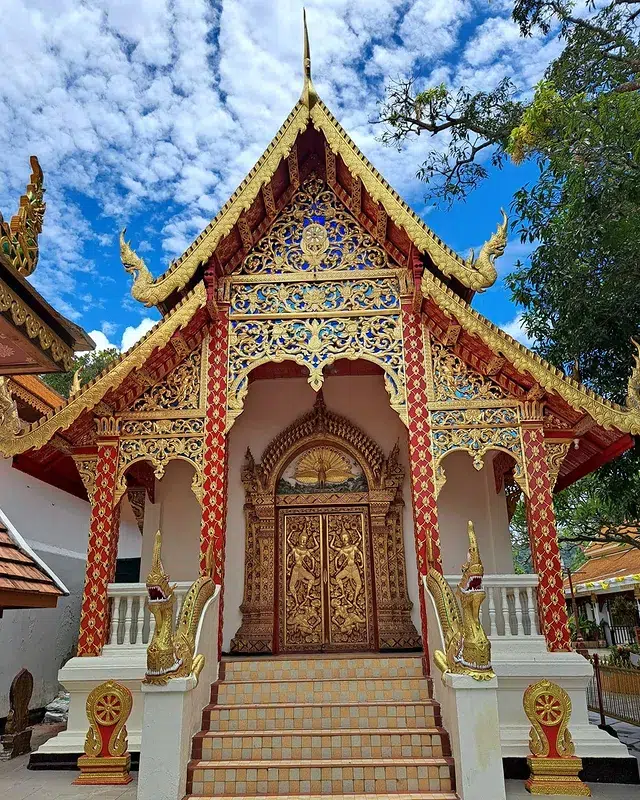
The Key Highlights:
- gold‑plated chedi
- Naga‑lined stairway (306 steps)
- tiered roofs, inward‑sloping walls, and trapezoidal windows
- murals and Buddha images
What does the temple look like?
The temple’s golden stupa shines brightly in the sun. If you look from the top angle, you can see the stupa surrounded by greenery. It is said that this temple holds a piece of the Buddha’s shoulder bone.
You can walk around the stupa, ring the bells, and enjoy views over the whole city with a cool breeze. Also, inside, you’ll find peaceful shrines, murals, and monks doing their daily prayers. The vibe? Calm, surreal and magical.
Nearby Attractions to Visit:
- Bhuping Palace (Royal winter residence with beautiful gardens, 10 min drive away)
- Mon Tha Than Waterfall (located in Doi Suthep-Pui National Park)
- Doi Pui Hmong Village (Cultural village with traditional hill tribe handicrafts)
Timings: 5 AM to 9 PM
Entry Fee: 30 THB (approximately 80 INR)
Wat Chedi Luang
“Luang” refers to a vast temple celebrated for housing the tallest Buddhist Chedi, to a height of 98 metres and 54 metres in diameter. Right in the heart of the Old City, you’ll find Wat Chedi Luang.
Inside the temple premises, you can find three temples: Wat Chedi Luang, Wat Ho Tham and Wat Sukmin. Wat Chedi Luang stands out as one of the top temples in Chiang Mai. Be sure to take part in the monk chats- it’s a great opportunity to learn about Buddhism!
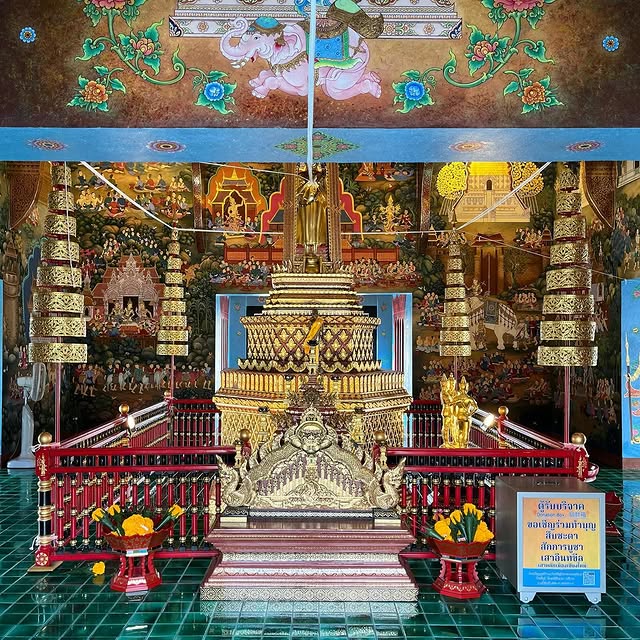
The Key Highlights:
-
- Original 14th–15th C chedi
- Pillar Shrine (Sao Inthakin)
- It has two wihan: The Reclining Buddha and the Phra Chao Attarot statue
What does the temple look like?
The massive stone chedi (pagoda) might look a bit weathered as it was damaged by an earthquake centuries ago, but that’s part of its charm.
Walk around the base and you’ll see elephant carvings, quiet corners for reflection, and lots of photo-worthy spots. The main prayer hall nearby has a large standing Buddha and gorgeous wooden beams inside.
This temple once housed the famous Emerald Buddha, now located in Bangkok – so, yes, it’s quite a significant temple in Chiang Mai, Thailand.
Nearby Attractions to Visit:
- Wat Phan Tao (a teakwood temple)
- Chiang Mai City Arts & Cultural Centre
- Sunday Walking Street Market (right outside on Sundays, perfect for food and souvenirs)
Timings: 5 AM to 10:30 PM
Entry Fee: 40 THB (approximately 110 INR)
Wat Phra Singh
Wat Phra Singh is one of the most loved Chiang Mai’s temples- and it’s easy to see why. The beauty of the classic Lanna-style buildings will surely steal your gaze!
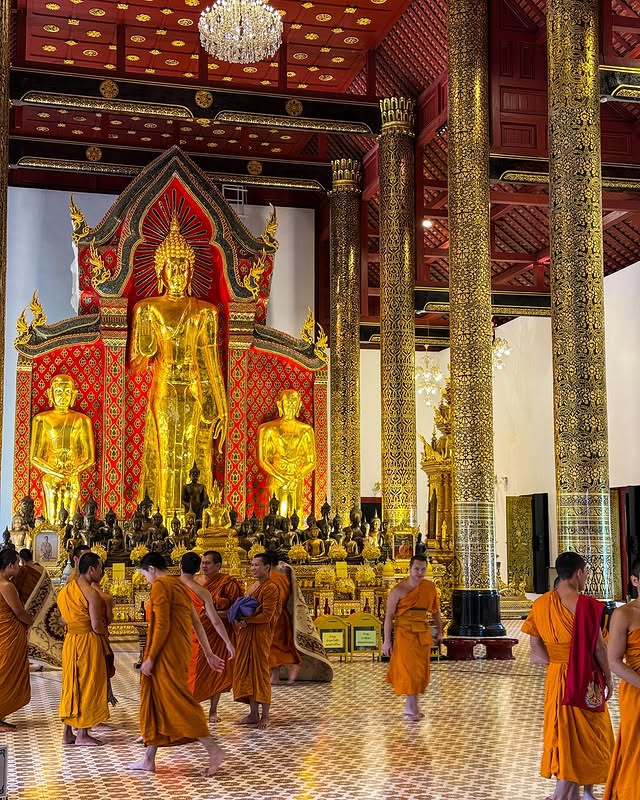
The Key Highlights:
- Lanna architecture, with Viharn Lai Kham (a type of assembly hall)
- Phra Singh Buddha statue (gold, gem‑encrusted)
- Ho Trai scripture library
What does the temple look like?
Describing the beauty of this temple is a little difficult, as it’s all picturesque. It is full of gold details, pretty gardens, and calm spaces to sit and reflect. From outside, the colours- red, white, brown and golden just fill your heart, and when you enter inside, the golden rays enlighten you!
The Phra Singh Buddha statue is believed to bring good luck. The main hall is stunning with red and gold interiors, and there’s also a lovely old scripture library that looks like it’s from a fairytale.
This temple is especially lively during Thai New Year (Songkran), so time your visit if you love a bit of festival fun.
Nearby Attractions to Visit:
- Three Kings Monument (a public square with iconic statues)
- Lanna Folklife Museum
- Rachadamnoen Road Cafés (a lovely local spot for a coffee or light bite)
Timings: 6 AM to 7:30 PM
Entry Fee: 40 THB (approximately 110 INR)
Wat Suan Dok
Wat Suan Dok is a calm and spacious temple with a mix of white chedis and golden stupas. Once, this place was a majestic garden for royalty, giving it the enchanting name that translates to “temple of the flower garden.”
Within its grounds lie the ashes of Chiang Mai’s royal lineage, carefully preserved in elegant white chedis that rise gracefully against the landscape. The big golden stupa in the centre shines bright at sunset.
There’s also a hall where you can join monk chats and learn more about Buddhist life.
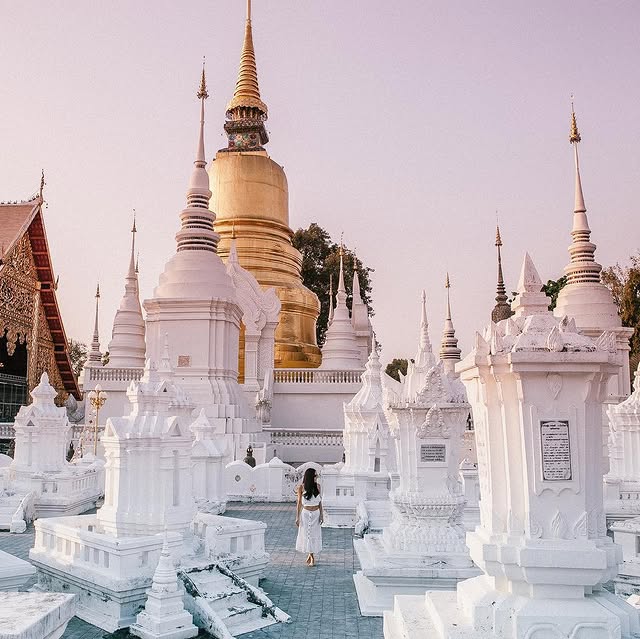
The Key Highlights:
- 48 m-high bell‑shaped chedi in Sri Lankan style
- A royal mausoleum
- Aala kan prian (pavilion)
- A Ubosot with a bronze Buddha
What does the temple look like?
White, white, golden, and green – can you imagine how beautiful and peaceful it looks? The gardens around the temple create a calm environment, ideal for relaxing walks among blooming flowers.
The Lanna-style temple’s architecture beautifully highlights the detailed woodwork and carvings. Inside, the ubosot features colourful murals that illustrate Buddhist teachings.
Nearby Attractions to Visit:
- Ton Payom Market (for fresh produce and snacks)
- CMU Art Centre (contemporary art museum)
- Nimmanhaemin Road (Trendy area with boutiques, cafés, and galleries)
Timings: 6 AM to 5 PM
Fee: Free
Wat Umong (The Tunnel Temple)
A unique historical temple famous for its ancient meditation tunnels and natural, quiet setting. It is located in the forest.
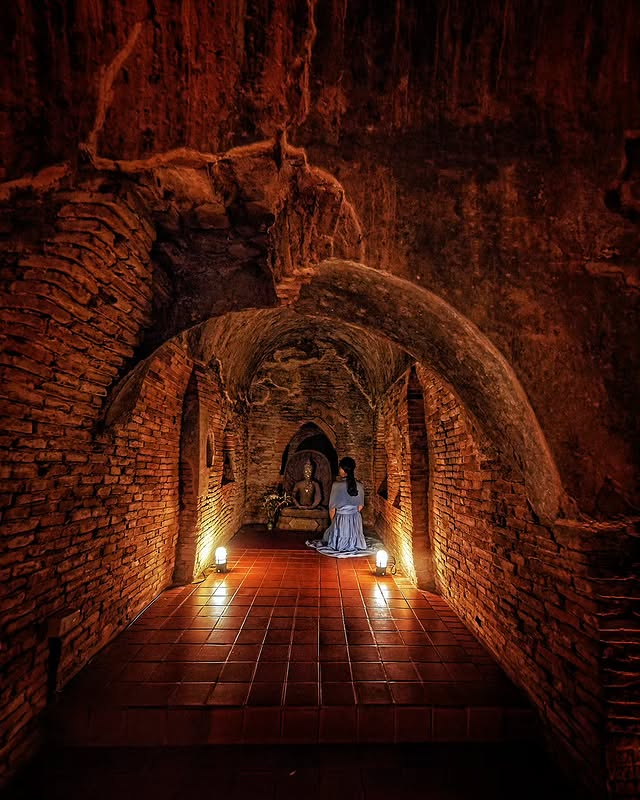
The Key Highlights:
- Rustic forest temple at Doi Suthep hills
- Large chedi
- Tunnelled walls with Buddhist images
What does the temple look like?
The tunnels are cool and mysterious, with Buddha statues tucked into little alcoves. You’ll also find a peaceful lake, a replica of the Ashoka pillar, and monks strolling under giant trees.
The main stupa is surrounded by lush gardens and a large lake, making it a peaceful spot for reflection. Visitors can observe resident monks and participate in meditation sessions, enjoying a harmonious blend of nature, spirituality, and history.
Nearby Attractions to Visit:
- Chiang Mai Night Safari (ideal if you’re visiting later in the day)
- Royal Park Rajapruek (botanical gardens and exhibitions)
- Wat Ram Poeng (Tapotaram) meditation retreat centre
Timings: 6 AM to 5 PM
Fee: Free
Wat Lok Moli
Wat Lok Moli has one of the oldest chedis in town, and it’s beautifully preserved. What’s unique? The temple faces north, which is rare. It’s usually quiet, so you can wander around without the crowds.
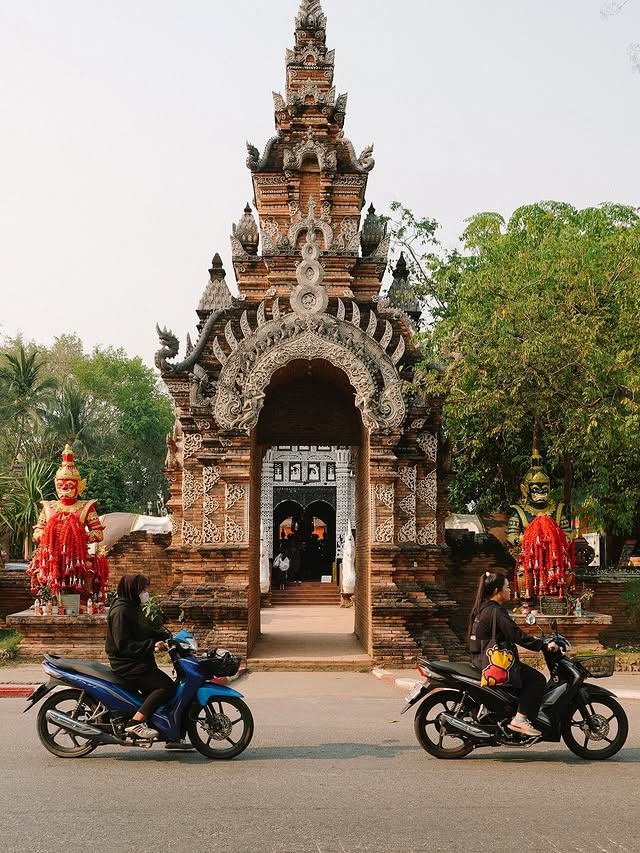
The Key Highlights:
- 1527 chedi
- Viharn with typical Lanna detailing
What does the temple look like?
The beauty of the temple lies in its traditional Lanna architecture, with brown, sloping roofs, complemented by white walls and white elephant statues. Take any angle or any frame; it makes your pictures worth uploading. The main prayer hall is made of dark teak wood, with carved details that are absolutely gorgeous.
Nearby Attractions to Visit:
- Chang Phuak Night Market
- Kad Suan Kaew Shopping Centre (local-style mall with quirky shops)
- Wat Rajamontean (another peaceful temple with a giant seated Buddha)
Timings: 6 AM to 5 PM
Fee: Free
Wat Sri Suphan (The Silver Temple)
Known as the Silver Temple, it’s covered head to toe in shiny silver panels- inside and out. Even the floor sparkles!
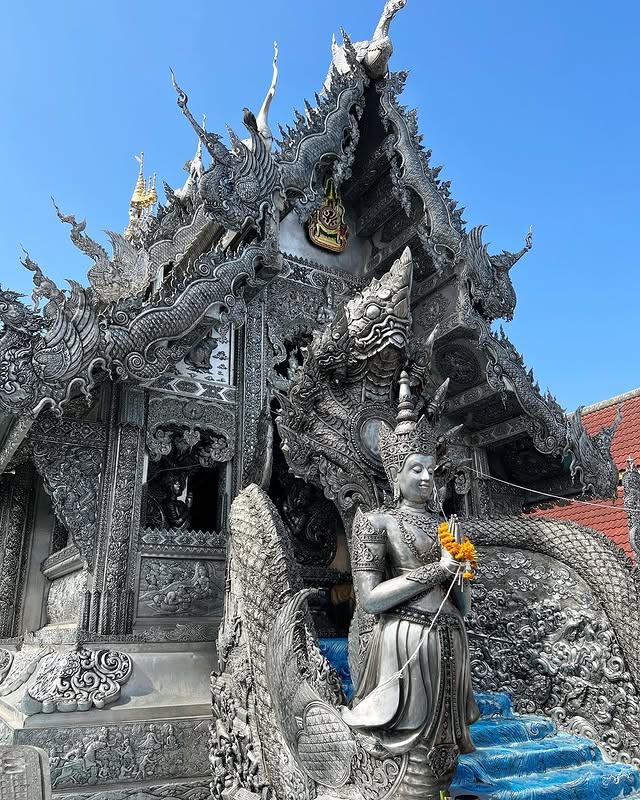
The Key Highlight:
- Silver Temple with silver‑plate ubosot
What does the temple look like?
You’ll find intricate metalwork showing Buddhist stories and teachings, and local silversmiths working nearby. While men are allowed inside the main ordination hall, sadly, women aren’t allowed inside the main ordination hall (due to traditional restrictions), but don’t worry- there’s still plenty to admire from outside.
Nearby Attractions to Visit:
- Wua Lai Walking Street (Saturday Night Market)
- Silver Handicraft Workshops
- Wat Muen San (another lesser-known silver temple nearby)
Timings: 6 AM to 9 PM
Fee: 50 THB (approximately 140 INR)
Wat Buppharam
Wat Buppharam is a quirky and colourful temple that often gets overlooked. The locals nicknamed it the “Donald Duck Temple” because of its quirky Donald Duck statue.
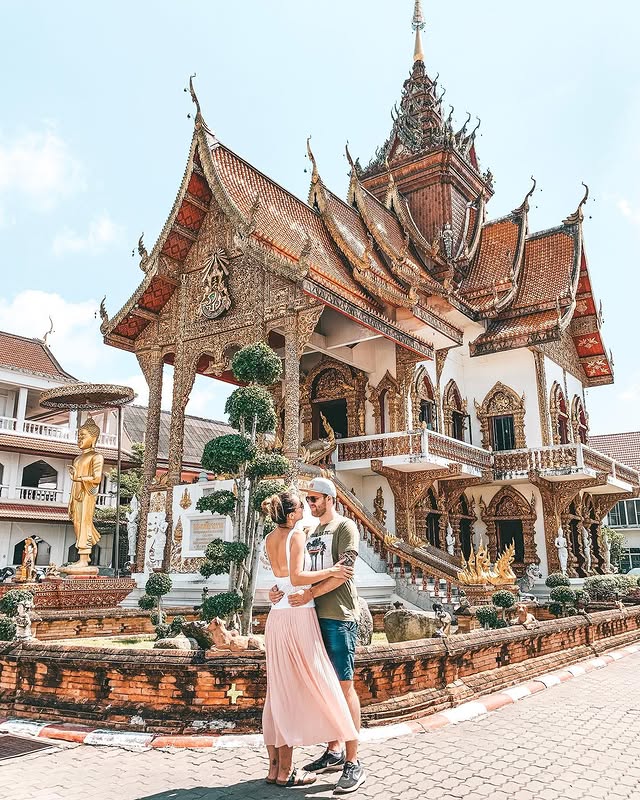
The Key Highlights:
- Lanna teak ubosot and viharn with mosaic
- Murals of Jataka tales
- Quirky Donald Duck statue in the garden
What does the temple look like?
Looking at this temple, you will feel like looking at a royal palace. It features a mix of Burmese and Lanna architecture, with decorations that are wonderfully detailed.
Be sure to look for the statue of a large, seated monk at the entrance, as well as the playful animal statues scattered throughout the gardens. This place is both fun and peaceful, making it a great stop if you’re staying in a nearby luxury hotel.
Nearby Attractions to Visit:
- Chiang Mai Night Bazaar
- Ploen Ruedee Night Market (food trucks, bars, and live music)
- Anusarn Market (night market with souvenirs and Thai massages)
Timings: 6 AM to 6 PM
Fee: Free
Wat Jed Yod (The Seven-Spired Temple)
Wat Jed Yod is something different. Built to resemble the Mahabodhi Temple in India, it features seven spires on one massive stupa- hence the name Jed Yod, which means “seven peaks.”
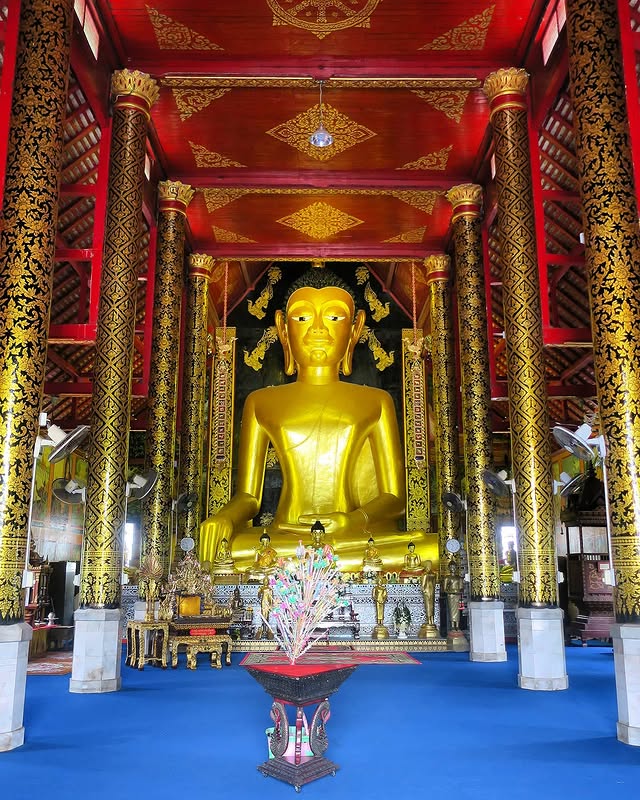
The Key Highlights:
What does the temple look like?
It’s a quiet temple with lovely grounds, big shady trees, and a peaceful feel. It’s especially popular during Visakha Bucha Day (Buddha’s birthday). Great for history lovers and those wanting a break from touristy spots.
Nearby Attractions to Visit:
- MAYA Lifestyle Shopping Centre
- Wat Chet Yot Arboretum (a peaceful park nearby for a short walk)
- One Nimman (a modern shopping and dining complex with local art and events)
Timings: 6 AM to 6 PM
Fee: Free
Wat Chiang Man
Wat Chiang Man was built around 1296, right when the city was founded (so, it’s the oldest). It is located in a quiet corner of the Old City and offers a peaceful atmosphere for visitors.
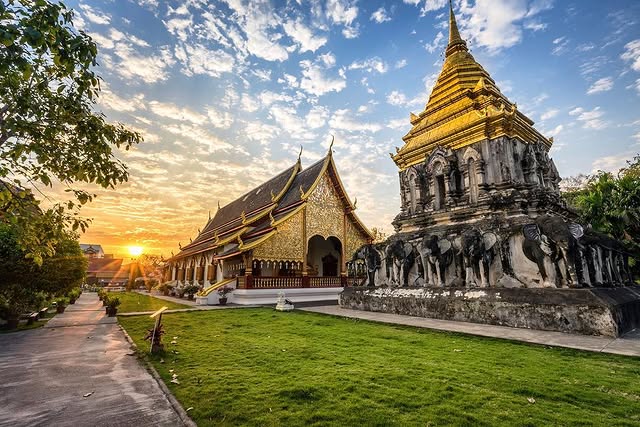
The Key Highlights:
- Elephant Chedi” – a two‑tiered square base
- traditional viharn and ubosot
What does the temple look like?
The complex is small but charming, with traditional Lanna architecture and plenty of space to sit and relax. It is known for its ancient elephant-backed chedi and two important Buddha images- one made of crystal and another of marble. These are believed to have protective powers and are especially respected by locals.
Nearby Attractions to Visit:
- Sompet Market (food market)
- Chang Puak Gate (one of the Old City’s historic gates, great for photos)
- North Gate Jazz Co-Op (catch live music in the evening)
Timings: 6:00 AM to 5:00 PM
Entry Fee: Free (donations welcome)
Things to Remember when Visiting Chiang Mai’s Temples
- Dress properly: When visiting temples, dress modestly- avoid short skirts, tank tops, and crop tops.
- Shoes off: Remember to remove your shoes before entering, as it’s a sign of respect.
- Be respectful: Maintain a low voice and refrain from public displays of affection to ensure a respectful atmosphere.
- Early mornings: Visiting early in the morning is ideal for cooler weather and fewer crowds, allowing for a more peaceful experience.
- Stay hydrated: Lastly, stay hydrated, especially during the heat of midday, to enjoy your visit comfortably.
Conclusion
There are many things to do in Chiang Mai, and visiting temples is one of them. It is more than just beautiful buildings. They offer a place for peace, reflection, and spiritual renewal.
If you want to find stillness, inspiration, or connect with Thai culture and nature, you can visit ethical elephant sanctuaries, which also offer an energy that lingers with you even after you leave.
Chiang Mai is a land that is even closer to nature and can provide many experiences to help you grow in life. Trying some outdoor adventurous activities can touch your heart and lift your spirit. So, must include these things in your itinerary.
Ready to experience the healing energy of Chiang Mai for yourself? Plan your temple exploration today and let the calm of Chiang Mai guide your path. In case you need any help, contact us, and we would be happy to help you!
FAQs on Chiang Mai Temples
What is the most famous temple in Chiang Mai?
Wat Phra That Doi Suthep is the most iconic temple, located on a mountain with stunning views of the city.
Are there entry fees for Chiang Mai temples?
Many temples are free, but some, like Wat Phra That Doi Suthep and Wat Chedi Luang, charge a small entrance fee (20–100 THB).
What should I wear when visiting temples?
Dress modestly- shoulders and knees should be covered. Remove shoes before entering temple buildings.
Can I take photos inside the temples?
Yes, but always check for signs. Flash photography and posing disrespectfully near Buddha statues are discouraged.
What are the top temples to visit in Chiang Mai?
Popular ones include- Wat Phra That Doi Suthep, Wat Chedi Luang, Wat Phra Singh, Wat Chiang Man, Wat Sri Suphan (Silver Temple)
When is the best time to visit the temples?
Mornings are ideal- less crowded and cooler. Avoid midday heat.
Are the temples open every day?
Yes, most temples are open daily from early morning to late afternoon.
Is there a temple etiquette I should follow?
Yes, be respectful, speak quietly, don’t point your feet toward Buddha, and ask before joining or photographing monks.